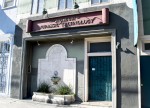There are more than 500 square miles of city surrounding UCLA’s campus, which takes up a minuscule fraction of that mileage. For such a big place, Los Angeles at times seems impossible to navigate. But don’t let size steer you away from your sense of adventure and curiosity. Each week this quarter, follow columnist Maryrose Kulick as she takes you to a new and affordable L.A. destination, to help you explore the city you call home.
It looked quaint on the outside – green exterior with a small, rustic fountain against the building. But upon entering, I saw the world around me change, as each new peculiar sight and sound pulled me through the dimly lit maze of exhibits.
The Museum of Jurassic Technology in Culver City is both peculiar and engrossing – I’ve never experienced anything quite like it. It contains everything from histories of strange scientific discoveries and incredibly intricate and obscure pieces of artwork to glorifications of the most mundane artifacts, such as smoking pipes and sewing needles. It aims to explore technologies and studies from a “Jurassic” time – to bring discoveries from past periods back into the present.
If you come to this museum expecting to take a break from your education, this may be the wrong place to go. What I thought would be no more than an hour-long visit quickly turned into almost three hours, as I soon realized no room could go unexplored, no display could go unexplained.
In one room, I could hear a multitude of sounds: dogs barking, bells ringing, choirs singing, flutes playing. All of these came from different exhibits, many of which were accompanied with interactive visual components. In essence, this museum was extremely distracting and knew exactly how to spark my curiosity.
At one point in my visit, I sat watching a 3-D video about how magnetism is the “golden chain” that connects everything in the universe – but my attention was soon diverted by the loud bells ringing in the next room. I wanted to go investigate, but on my way I was stopped by another peculiar bit of technology: the sunflower clock, a device developed by Athanasius Kircher in 1641 to explain the magnetic relationship between vegetation and solar energy.
The museum highlighted things I never thought would have existed.
One exhibit showcased a collection of micromosaics by Henry “Harold” Dalton. The mosaics depict images mostly of birds and floral designs and are made of the scales from butterfly wings. It required a microscope to view them. In another miniature collection by Hagop Sandaldjian, tiny figurines were masterfully sculpted inside the eye of a sewing needle.
The list of this museum’s collections could probably go on for miles with all of its variation. In one room there is a history of camping trailers, while in another you’ll find a collection of extinct French moths. I also learned, across the hall, about the folk remedy of eating mice – fur and all – on toast, to prevent wetting the bed. Who knew?
Upon venturing upstairs, where sculptures of stairs are artfully displayed, the mood gets a little brighter. After playing with some string in the cat’s cradle room and admiring oil paintings commemorating all of the dogs that were sent to space in the Soviet space program, I entered the Tula Tea Room, where I was served a glass of Georgian black tea with a slice of lemon and some cubes of sugar.
The tea room was normal and relaxing in contrast to the dark, perplexing world of downstairs. In a room decorated with pastel colors and antique musical instruments, I was able to calmly contemplate my experience while sipping my tea and observing two dogs nonchalantly lounging on the floor.
Upstairs from the tea room was a beautiful find – a courtyard garden with stone architecture and vibrant greenery. Doves made this little oasis their home, and they greeted me like houseguests with flutters of their wings.
While the sights of the museum are more than compelling, photography and cellphone use are not allowed whatsoever. The museum provides an environment that is truly an escape from the outside world, and you’ll learn things that you’d probably never learn in a lecture hall. Even though it might be painful on your day off, bringing a pen and paper to take notes, or at least draw pictures, is a good idea, because you definitely won’t want to forget this experience.
